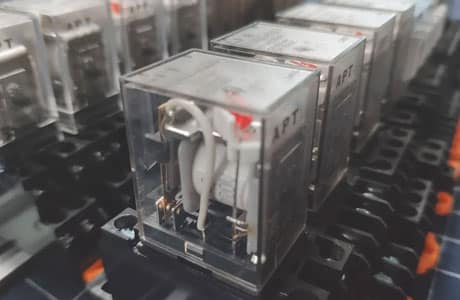Key Takeaway
Relays are essential in PLC (Programmable Logic Controllers) systems because they act as intermediaries between the PLC and the devices it controls. A relay allows a PLC to operate heavy-duty machinery, lights, or other electrical devices with high voltage or current requirements, which the PLC itself cannot handle directly. This setup ensures that the PLC can safely control these devices without risk of damage or overload. Additionally, relays can be used to receive input signals from various sensors, making them versatile components in automation systems, enhancing both control and safety.
Interface Between Signals
Relays serve as an interface between different types of signals in a PLC system. PLCs typically operate at low voltages and currents, which are insufficient to directly control high-power devices such as motors, heaters, and large lighting systems. Relays bridge this gap by allowing the low-power control signals from the PLC to switch higher power loads. This interfacing capability ensures that the PLC can effectively manage and control various devices in the automation process without being directly exposed to high-power circuits. This separation helps in protecting the PLC and ensures reliable operation across the system.

Electrical Isolation
Electrical isolation is one of the most critical reasons for using relays in PLC systems. Relays provide a barrier between the PLC’s low-voltage control side and the high-voltage load side. This isolation is crucial for protecting the sensitive components of the PLC from voltage spikes, surges, and other electrical disturbances that may occur in the high-power load circuits. For instance, if there is a sudden surge in the load circuit, the relay prevents this surge from reaching the PLC, thereby safeguarding its delicate electronics. This not only ensures the longevity and reliability of the PLC but also minimizes downtime and maintenance costs.
Moreover, electrical isolation enhances safety by reducing the risk of electrical shocks and short circuits. By isolating the control circuitry from the load circuitry, relays ensure that any faults in the load circuit do not affect the control system. This is particularly important in industrial environments where safety is paramount. In such settings, electrical isolation provided by relays helps in maintaining a safe working environment for personnel and protecting expensive equipment from damage.
You May Like to Read
Load Switching
Relays are used for load switching in PLC systems, allowing the PLC to control various types of loads such as motors, lights, and heaters. By using relays, PLCs can switch high-current loads on and off without the need for high-power switching components within the PLC itself. This capability is particularly important in industrial environments where equipment often operates at high voltages and currents. For instance, in a manufacturing plant, a PLC can use relays to start and stop conveyor belts, control robotic arms, and manage other machinery.
This ability to switch large loads efficiently and reliably ensures smooth and coordinated operation of the industrial processes. Relays handle the high power required by the loads, while the PLC provides the control signals. This division of labor allows the PLC to focus on processing control logic and monitoring system status without being burdened by the high-power demands of the load circuits. Thus, relays play a crucial role in enabling PLCs to manage complex and high-power industrial operations effectively, ensuring productivity and operational efficiency.
Safety Features
Relays contribute significantly to the safety features of PLC systems by providing mechanisms to disconnect loads in case of faults or emergencies. For example, relays can be used to create safety interlocks that prevent machinery from operating under unsafe conditions. In the event of a detected fault or an emergency stop command, the relay can immediately disconnect the load, preventing potential damage or injury. This safety functionality is crucial in industrial settings where the failure to quickly and effectively disconnect power can lead to hazardous situations.
By isolating and managing loads, relays enhance the overall safety of PLC-controlled systems. They provide a reliable means to ensure that machinery and equipment operate only under safe conditions. For instance, if a sensor detects an abnormal condition in a machine, the PLC can send a signal to a relay to disconnect the power, thereby averting possible accidents. This capability is essential for maintaining a safe working environment and protecting both personnel and equipment from harm.
Control Flexibility
Relays offer significant control flexibility in PLC systems, allowing for complex control logic to be implemented. They enable PLCs to manage multiple devices and systems simultaneously. Relays can be used to implement various control strategies, such as sequencing, timing, and interlocking, which are essential for automated processes. This flexibility allows PLCs to adapt to different operational requirements and configurations, making them versatile tools in industrial automation.
For instance, a PLC can use relays to control the timing of different stages in a production process, ensuring that each stage operates in the correct sequence and timing, enhancing efficiency and productivity. Relays can also facilitate the interlocking of machines, ensuring that certain operations cannot proceed until others are completed, thus maintaining orderly and safe workflows. This adaptability makes relays indispensable in creating efficient, flexible, and reliable control systems that can meet diverse industrial needs.
Conclusion
Relays are indispensable in PLC systems, providing essential functions such as interfacing between signals, electrical isolation, load switching, safety features, and control flexibility. By integrating relays into PLC systems, engineers can ensure efficient, reliable, and safe operation of automated processes. Understanding the role of relays in PLCs is crucial for designing robust and versatile control systems that meet the demands of modern industrial automation. For newly joined engineers, mastering the use of relays in PLC applications is a vital skill for ensuring the optimal performance and safety of automated systems.
